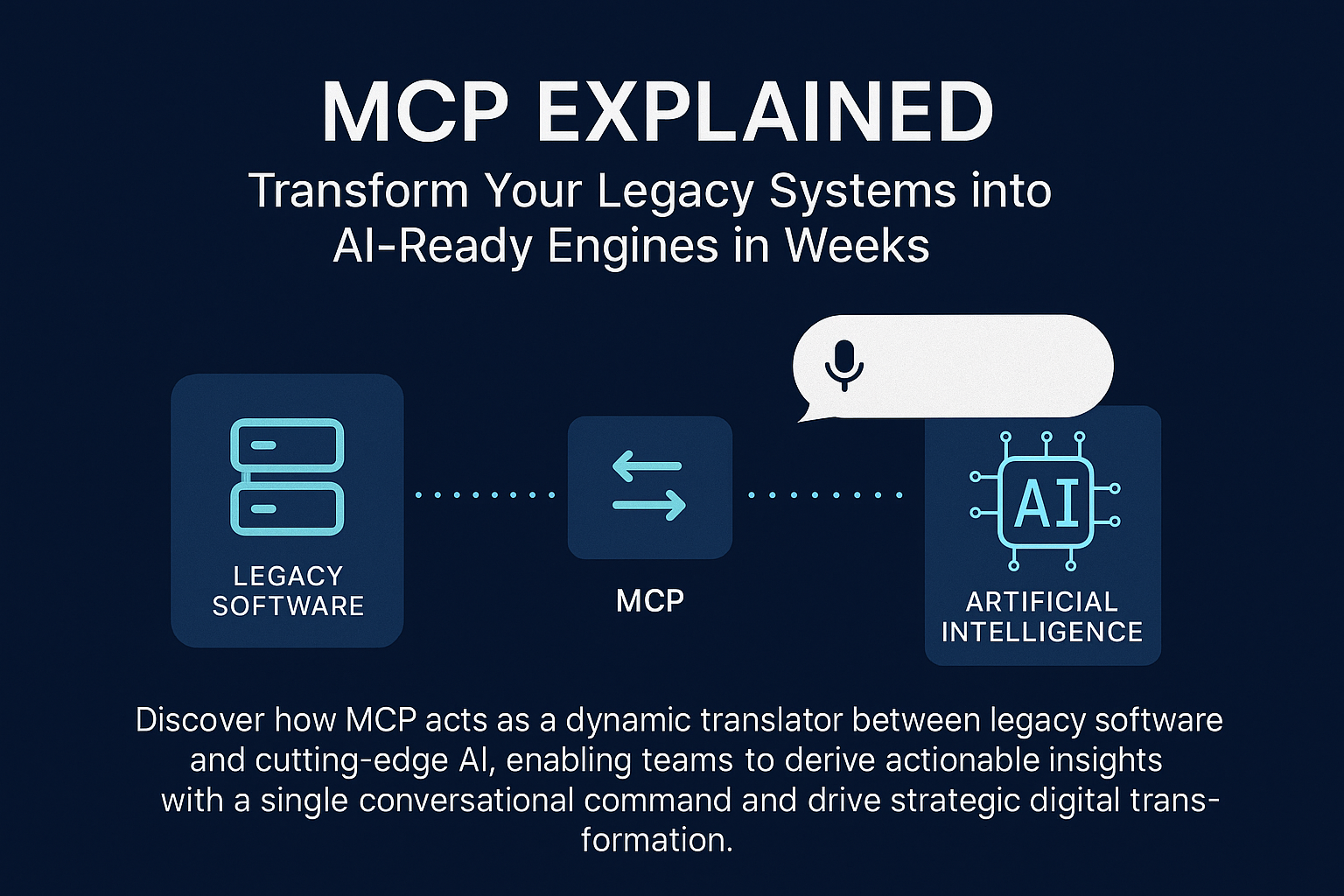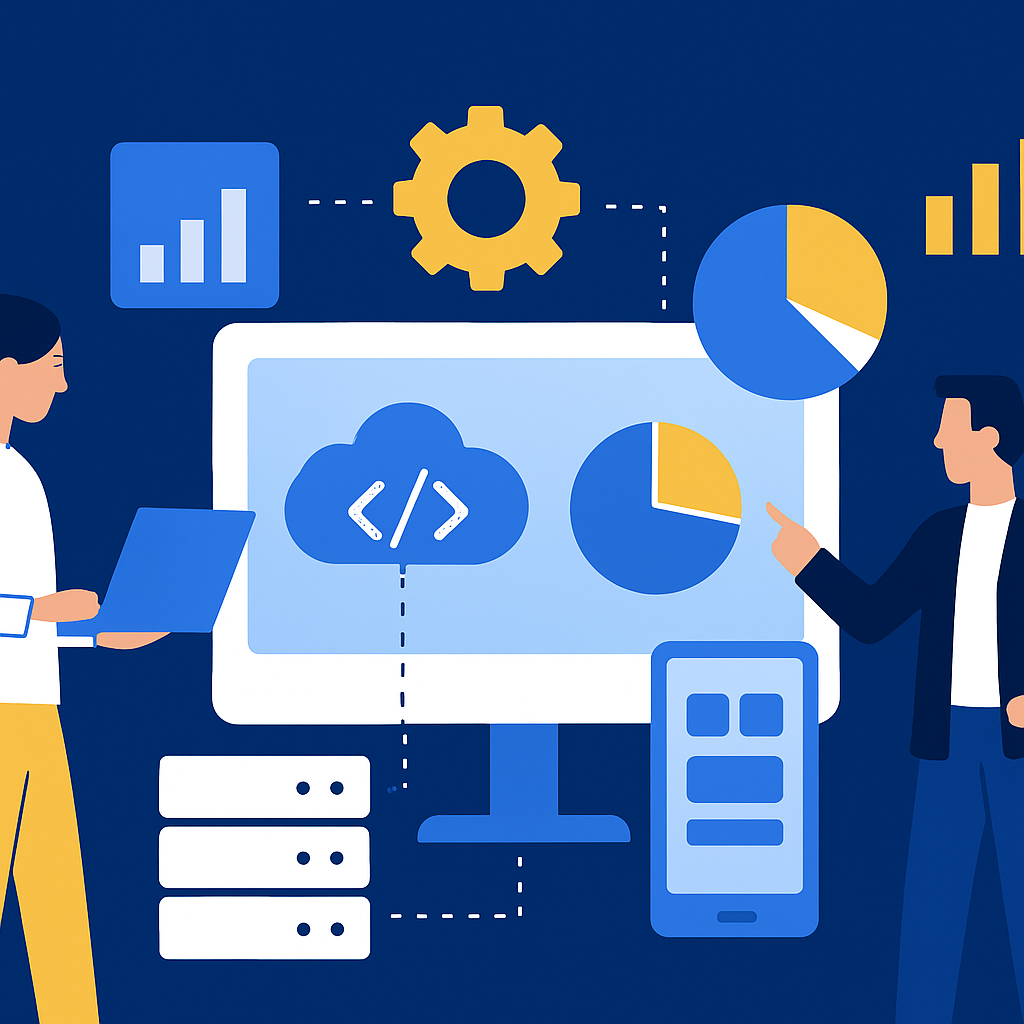
The Legacy System AI Paradox
Your legacy systems contain decades of refined business logic, critical operational data, and institutional knowledge that new systems simply cannot replicate. They work reliably, processing millions of transactions, supporting business operations, and containing data that is genuinely irreplaceable.
But they were built before modern APIs, before cloud architecture, before AI. The result? AI initiatives stall because models cannot access the data and functionality they need. Organizations face an impossible choice: spend years modernizing systems that work perfectly well, or forgo AI capabilities that could transform operations.
The Model Context Protocol (MCP) solves this paradox by acting as a universal adapter layer—enabling AI systems to interact with any system, regardless of age or architecture, without requiring expensive, risky modernization projects.
What Model Context Protocol Actually Is
Model Context Protocol is an open standard developed by Anthropic that defines how AI systems interact with external data sources and tools. Think of it as a universal translator between AI models and the systems they need to access.
At its core, MCP provides:
Standardized Interface: AI systems interact with MCP using consistent methods regardless of what system sits behind it—whether a modern cloud API or a 1980s mainframe.
Context Management: MCP handles the complex task of providing AI models with appropriate context about available data and operations, enabling models to interact intelligently.
Security Abstraction: Authentication, authorization, and data protection are handled by MCP servers, not embedded in AI models themselves.
Resource Discovery: AI systems can discover available data sources and capabilities dynamically, adapting to what is available rather than requiring hardcoded integrations.
How MCP Transforms Legacy System Access
The power of MCP becomes clear when connecting AI to legacy systems. Traditional integration approaches require extensive custom development. MCP provides a standardized pattern that dramatically reduces complexity.
Traditional Legacy AI Integration
Without MCP, connecting AI to legacy systems requires:
- Custom API development wrapping legacy system access
- Security layer implementation for AI system authentication
- Data transformation logic converting legacy formats to AI-consumable structures
- Error handling and retry logic for unreliable legacy connections
- Documentation and maintenance of custom integration code
This approach consumes months of development time, requires specialized knowledge of legacy systems, creates brittle integrations that break with system changes, and must be repeated for each AI use case.
MCP-Based Legacy AI Integration
With MCP, the same integration becomes:
- Deploy MCP server configured for your legacy system
- Configure access permissions and security policies
- Connect AI systems to MCP server using standardized protocol
- AI systems automatically discover and interact with legacy data and functions
This approach deploys in weeks instead of months, requires less specialized legacy system knowledge, creates maintainable integrations through standardized patterns, and supports multiple AI use cases with single implementation.
Real-World Legacy System MCP Implementations
Manufacturing: ERP System AI Integration
A global manufacturer needed AI to optimize production schedules using data locked in a 20-year-old ERP system. Traditional integration would have required 6 months of custom development by developers familiar with the legacy system.
Using MCP:
- Week 1-2: Deployed MCP server with database connectors for ERP backend
- Week 3: Configured security policies and data access rules
- Week 4: Connected AI optimization models to MCP interface
- Week 5-6: Testing and production deployment
The AI now queries production data, inventory levels, and scheduling constraints conversationally through MCP—generating optimized schedules that improved line utilization by 18%.
Healthcare: Patient Records AI Analysis
A healthcare system operated multiple legacy electronic health record systems, each with proprietary data formats and access methods. Analyzing patient outcomes across systems was nearly impossible.
MCP implementation provided unified interface to all legacy systems. AI models accessed patient data through standardized MCP queries regardless of which legacy system held the data. The AI identified treatment patterns, predicted readmission risks, and generated insights that improved patient outcomes—all without modernizing underlying legacy systems.
Financial Services: Regulatory Compliance
A bank needed AI to analyze transactions for compliance violations, but transaction data resided in mainframe systems built in the 1980s. Direct mainframe access by AI systems was prohibited by security policies.
MCP server acted as secure intermediary. The mainframe remained isolated behind existing security controls. AI systems accessed necessary transaction data through MCP interface with appropriate security logging and access controls. Compliance analysis that previously required teams of analysts now happens automatically, identifying issues in minutes instead of weeks.
Technical Architecture of MCP for Legacy Systems
MCP Server Layer
The MCP server sits between AI systems and legacy infrastructure, translating standardized MCP requests into whatever protocols legacy systems understand—database queries, REST APIs, SOAP calls, file system access, or even mainframe transaction processing.
Connector Modules
Connectors handle legacy system-specific communication:
Database Connectors: SQL Server, Oracle, DB2, and other database systems common in legacy environments.
API Connectors: REST, SOAP, XML-RPC, and custom protocols used by legacy applications.
File System Connectors: Access to structured and unstructured data in file systems and document repositories.
Mainframe Connectors: Integration with CICS, IMS, and other mainframe transaction systems.
Security and Governance
MCP provides centralized security controls:
Authentication: AI systems authenticate with MCP server, not directly with legacy systems.
Authorization: Fine-grained access controls define what data and operations AI systems can access.
Audit Logging: Complete logging of AI access to legacy data for compliance and security monitoring.
Data Masking: Automatic masking of sensitive data before delivery to AI systems.
Implementation Approach
Phase 1: Assessment and Planning (1-2 Weeks)
Identify legacy systems containing data needed for AI initiatives. Evaluate existing access methods, security requirements, and data sensitivity. Select appropriate MCP connectors for your legacy system landscape. Define security policies and access controls.
Phase 2: MCP Server Deployment (2-3 Weeks)
Deploy MCP server infrastructure in appropriate environment (cloud, on-premises, or hybrid). Install and configure connectors for legacy systems. Implement security policies, authentication, and authorization. Test connectivity to legacy systems.
Phase 3: AI System Integration (1-2 Weeks)
Connect AI systems to MCP servers using standard protocol. Configure AI models with context about available data and operations. Implement monitoring and logging for AI access patterns. Test end-to-end workflows with real scenarios.
Phase 4: Production Deployment and Optimization (2-3 Weeks)
Roll out AI capabilities to production users. Monitor performance and access patterns. Optimize queries and data access based on actual usage. Expand to additional legacy systems and AI use cases.
Benefits Beyond AI Enablement
MCP provides value beyond just AI integration:
API Standardization: MCP creates consistent interfaces to legacy systems useful for all modern applications, not just AI.
Security Modernization: Centralizing legacy system access through MCP enables modern security controls without modifying legacy systems.
Integration Simplification: New applications integrate more easily when legacy access is standardized through MCP.
Migration Path: MCP provides abstraction layer enabling gradual legacy system modernization without disrupting dependent applications.
Common Implementation Challenges
Legacy System Performance: Some legacy systems are not designed for real-time queries AI systems generate. Implement caching and query optimization to mitigate.
Data Quality: Legacy systems often contain data quality issues invisible until AI systems start analyzing data at scale. Plan for data cleaning efforts.
Security Complexity: Mapping modern security models to legacy system permissions can be complex. Work with security teams early to define appropriate policies.
Change Management: IT teams accustomed to tightly controlling legacy system access may resist opening access through MCP. Build consensus around security model and governance framework.
The Future of Legacy System AI Integration
MCP represents a fundamental shift in how organizations approach legacy modernization. Rather than expensive, risky replacement projects, organizations can enable modern AI capabilities while preserving existing system investments.
As the MCP ecosystem grows, expect expanding connector libraries supporting more legacy systems, AI models optimized for MCP interaction, and industry-specific MCP implementations addressing vertical-specific challenges.
Organizations implementing MCP today are building competitive advantage through faster AI deployment, lower integration costs, and preserved legacy system investments.
Ready to make your legacy systems AI-ready? Contact QueryNow for an MCP integration assessment. We will evaluate your legacy system landscape, identify high-value AI use cases, and develop an implementation roadmap that leverages MCP to unlock AI capabilities without risky modernization projects.


